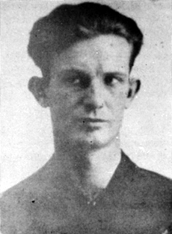 Many of the new generation know little of the hectic pre-1920 days when the roaring oil boom hit, briefly increasing the population to 10 times what it is today. Once known as Avenue D, the city’s main street is now called Conrad Hilton Avenue, in honor of the famed hotelier who came to town and launched an empire with the impulsive purchase of the local Mobley Hotel. And the old First National Bank long ago moved from its middle-of-downtown location. For a time the one-story red brick building, originally a retail store, became an auto parts shop, then was abandoned. Today it sits vacant, with only a Texas State Historical Commission plaque to proclaim it the site of the darkest, most violent day in the town’s history. The events that occurred there 80 years ago are now but a historical whisper, an ill-planned escapade that, like a precursor to some Coen brothers movie, was daring, dim-witted, and deadly. They took place just two days before Christmas in 1927, turning the town’s holiday anticipation into a day of blind fear, reckless greed, and back-alley bloodshed. And the violent aftermath continued for years – a hanging, escape attempts, a new round of death.
Many of the new generation know little of the hectic pre-1920 days when the roaring oil boom hit, briefly increasing the population to 10 times what it is today. Once known as Avenue D, the city’s main street is now called Conrad Hilton Avenue, in honor of the famed hotelier who came to town and launched an empire with the impulsive purchase of the local Mobley Hotel. And the old First National Bank long ago moved from its middle-of-downtown location. For a time the one-story red brick building, originally a retail store, became an auto parts shop, then was abandoned. Today it sits vacant, with only a Texas State Historical Commission plaque to proclaim it the site of the darkest, most violent day in the town’s history. The events that occurred there 80 years ago are now but a historical whisper, an ill-planned escapade that, like a precursor to some Coen brothers movie, was daring, dim-witted, and deadly. They took place just two days before Christmas in 1927, turning the town’s holiday anticipation into a day of blind fear, reckless greed, and back-alley bloodshed. And the violent aftermath continued for years – a hanging, escape attempts, a new round of death.
That day, four men, their leader dressed in a Santa Claus suit and beard, terrorized downtown Cisco and assured themselves an infamous place in Texas criminal history. Over the years, Texas writers and historians, including author A.C. Greene (The Santa Claus Bank Robbery) and Cisco Junior College playwright Billy Smith (The Great Santa Claus Bank Robbery) have kept the strange and fascinating tale alive. The First National Bank gives its customers a booklet recounting the event, and the local chamber of commerce offers a chapbook (The Santa Claus Bank Robbery and its Impact on Eye Witnesses) by Duane Kendall Hale. On TexasEscapes.com, you’ll find chronicles of the events written by Maggie Van Ostrand and John Troesser. And, as with all bigger-than-life legends, the passage of time has caused more than an occasional detour from fact. Eventually, the number of supposed eyewitnesses to the famed robbery, the shoot-out, and the manhunt that followed would include virtually the whole Cisco population at the time. Everyone had a story to tell; everyone wanted to be remembered as a participant in history.
Were it not for the tragic loss of lives and later mob violence that sullied the reputation of a nearby town, the story would read like a pulp novel, a dark comedy in which the bad guys simply weren’t very good at their ill-chosen criminal craft, but kept coming back for several bloody sequels. Robbing banks was something at which Marshall Ratliff was determined to excel. The always-in-trouble 24-year-old, whose mother ran a small café in Cisco, first tried it with his brother Lee in the mid-1920s in the small Coleman County community of Valera, and, had it not been for their bragging afterward, they might never have been caught. However, when the local sheriff learned of the two young men who were living it up in Abilene, spending freely, and drunkenly boasting of their recent crime, he arrested them. They were shortly thereafter tried, convicted, and sent to prison. Paroled after only one year, they briefly wandered West Texas, unsuccessfully searching for oil-field work before settling in a boarding house in Wichita Falls. By the fall of 1927, Marshall was convinced there was no legitimate career future for an ex-con and began to plan another heist.
This time his target would be the bank, rich with oil money, in his hometown of Cisco. The planning would be letter-perfect, the get-away clean, and, most important, mouths would remain shut afterward. Ratliff envisioned a four-man team that would execute the robbery in a matter of minutes: he and three accomplices inside, to keep everyone in the bank under control while he gathered the money, and a car positioned in the alley. Everyone would be heavily armed. He persuaded two other ex-cons, Henry Helms, 32, and Robert Hill, 21, whom he’d met in Huntsville, to join him and his brother for the robbery. If ever there was a story to demonstrate that even the best-laid plans are often doomed to fail, this is it. The first problem occurred when the less-than-scholarly Lee Ratliff committed a spur-of-the-moment burglary in Wichita Falls, was arrested, and sent back to prison. At the last minute, Marshall Ratliff recruited a relative of Helms’ named Louis Davis, a 22-year-old family man with no criminal background but an increasingly desperate need for money to take care of his wife and children.
The necessity of last-minute recruiting failed to dent Ratliff’s confidence in his plan. He’d even obtained a disguise that he was sure would prevent anyone in his hometown from recognizing him. His landlady, Midge Tellet, had sewn a Santa Claus suit for her husband to wear on Christmas Day, complete with a large white beard and a red stocking cap. Ratliff had persuaded her to let him borrow it, promising to have it back in time for her family’s holiday celebration. Rather than hiding his face with nothing more than a bandana, Ratliff would walk into the First National Bank innocently dressed as jolly ol’ Saint Nick. On the early evening of Dec. 22, 1927, the four men set out on the 200-mile drive to Cisco in a stolen Buick that, luckily, had a full tank of gas. Driving into the night, they drank bootleg whiskey and shared boisterous plans about what they would do with the wealth that would soon be theirs. It was well after midnight when they arrived at the oil-field camp called Moran, home of Davis’ sister. When her husband refused to allow the drunken late-night travelers into his house, they borrowed a tent and slept in the front yard.
Shortly before noon on an unseasonably warm Friday, the blue Buick arrived on the outskirts of Cisco, its occupants hung over and weary from the trip and only a couple of hours’ sleep. Ratliff, dressed in his Santa suit, crouched down on the floorboard until they were within a couple of blocks of their target. Then he quickly got out and began walking along the Main Street sidewalk, waving at downtown shoppers and patting the heads of children excited by his sudden appearance. Hill took the car to a pre-planned spot in the alley near the bank’s back door. The Santa suit certainly obscured Ratliff’s identity, but you could say that it – and a little girl – were also the robbers’ undoing. Across the street, 6-year-old Frances Blasengame saw Santa entering the First National and urged her mother to take her to see him so she could remind him of what she wanted for Christmas. As the mother and daughter hurried across the street, Ratliff was already inside, responding to the friendly acknowledgments of the bank staff, customers, and two other children, Emma May Robinson, 10, and Laverne Comer, 12. Moments after Mrs. Blasengame and her daughter entered, Santa’s accomplices, pistols drawn, pushed past them into the lobby. The robbery was under way.
Davis took his position guarding the door while Helms and Hill pointed guns at the employees and customers. Ratliff, the only robber whose face was hidden, ordered teller Jewel Poe to open the safe. All was going as planned – except that the back door apparently had been left unguarded. Before the robbers could block her path, Mrs. Blasengame suddenly rushed her daughter out that door. Once in the alley, the mother and daughter ran the half block to city hall, calling out for Police Chief G.E. “Bit” Bedford. “The First National Bank’s being robbed,” Blasengame yelled. The 6-foot 4-inch, 220-pound Bedford, a 25-year law enforcement veteran, grabbed riot guns from the rack behind his desk and tossed one to Assistant Chief George Carmichael, another to Officer R.T. Redies. As they ran toward the bank, Bedford instructed his officers to take position in the alley while he covered the bank’s front door.
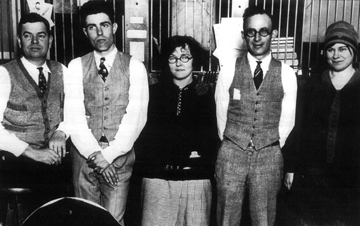 Inside, Ratliff had pulled a tow sack from beneath his Santa suit and was filling it with $12,000 in cash and $150,000 worth of security bonds. Less than five minutes had passed since his arrival. Ratliff was signaling the others that they were done when Helms noticed a face suddenly pressed against the window of the bank’s locked front door. Instinctively, he fired a warning shot toward the door. To his surprise, it was answered by a volley of gunfire from outside the bank. The robbers wildly returned fire in the direction of the doorways. It soon became obvious that there were more shooters outside than just the three-member Cisco police department. Inside and out, all hell was breaking loose.
Inside, Ratliff had pulled a tow sack from beneath his Santa suit and was filling it with $12,000 in cash and $150,000 worth of security bonds. Less than five minutes had passed since his arrival. Ratliff was signaling the others that they were done when Helms noticed a face suddenly pressed against the window of the bank’s locked front door. Instinctively, he fired a warning shot toward the door. To his surprise, it was answered by a volley of gunfire from outside the bank. The robbers wildly returned fire in the direction of the doorways. It soon became obvious that there were more shooters outside than just the three-member Cisco police department. Inside and out, all hell was breaking loose.
Earlier in the year, the Texas Bankers Association, upset over the fact that small banks throughout the state were being robbed almost daily, had announced a $5,000 reward to any citizen who shot and killed a bank robber during the commission of his crime. The possibility of earning such a reward was not lost on the people of Cisco. As soon as the gunfire between the robbers and local police started, dozens of armed citizens began arriving at the bank. At a nearby hardware store, the owner was passing out shotguns, pistols, and ammunition to anyone who came through his doors. Inside the bank, meanwhile, Ratliff was frantically devising a plan to use the employees and customers as human shields while he and his fellow robbers attempted to make it to their waiting car.
As the gunfire increased, several hostages were hit – and not necessarily by the robbers – when they stepped into the alley. Bank cashier Alex Spears was shot in the jaw. Local grocer Oscar Cliett, who had been in the bank to make a deposit, suffered a bullet wound to his foot, and Marion Olson, a Harvard student home for the holidays, was shot in the thigh. Ratliff, though shielding himself with bank teller Freda Stroebel, suffered injuries to the leg and jaw. Fellow robber Davis was even more seriously wounded, barely making it into the waiting sedan. His accomplices piled in; other hostages escaped, but the men held on to Emma May and Laverne, the young girls. As the car sped down the alley, the robbers shot Officer Carmichael in the head, and he slumped against the wall, near death. Moments later Chief Bedford, trying to stop the robbers as their car left the alley, was riddled with five gunshots.
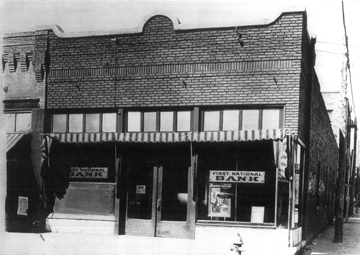 As the robbers raced down Main Street, Cisco citizens continued to blast away at the car. Of an estimated 100 or so shots, only one appeared to do any damage, but it was an important hit – it punctured a back tire. On the edge of town, briefly out of range of the pursuing townspeople, the bandits stopped to assess their fast-deteriorating situation. Two of them were bleeding badly, a tire was flat, and – if you’re looking for a bit of comic relief at this point – the needle of the Buick’s gas gauge was on empty. For all the careful planning, no one had thought to gas up the car following their lengthy trip from Wichita Falls. It would only get worse for the bumbling bandits.
As the robbers raced down Main Street, Cisco citizens continued to blast away at the car. Of an estimated 100 or so shots, only one appeared to do any damage, but it was an important hit – it punctured a back tire. On the edge of town, briefly out of range of the pursuing townspeople, the bandits stopped to assess their fast-deteriorating situation. Two of them were bleeding badly, a tire was flat, and – if you’re looking for a bit of comic relief at this point – the needle of the Buick’s gas gauge was on empty. For all the careful planning, no one had thought to gas up the car following their lengthy trip from Wichita Falls. It would only get worse for the bumbling bandits.
As an Oldsmobile driven by 14-year-old Rising Star schoolboy Woodrow Harris approached, the robbers blocked the road, stopped the car, and ordered the youngster, his parents, and grandmother to get out and run for their lives. The bandits lifted the nearly unconscious Davis into the backseat of the new getaway vehicle, and Ratliff pitched in the tow sack of stolen money and bonds, as Hill fired at the oncoming posse. A rifle shot from one of those in pursuit struck Hill in the arm, knocking him to the ground. He got up and scrambled to the newly stolen car, only to learn that the quick-thinking teenage driver had taken the keys with him as he and his family fled to the safety of a nearby farmhouse. With the pursuing vigilantes getting closer, and now joined by law enforcement personnel from nearby towns, the robbers and their young hostages hurried back to their limping Buick and drove off. Left behind in Harris’ Buick was the badly wounded Davis – and Ratliff’s tow sack containing their loot.
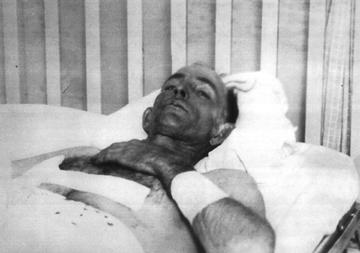 The remaining partners in crime managed to get only a few miles down an Eastland County back road before it became necessary to abandon their car and continue their escape on foot. When authorities located the bullet-riddled Buick, the two young girls were huddled in the back seat, crying and frightened but unharmed. Next to one of them lay a discarded Santa Claus suit. The good news that the hostages were safe was soon muted by the message, later that day, that Bedford had died without ever regaining consciousness.
The remaining partners in crime managed to get only a few miles down an Eastland County back road before it became necessary to abandon their car and continue their escape on foot. When authorities located the bullet-riddled Buick, the two young girls were huddled in the back seat, crying and frightened but unharmed. Next to one of them lay a discarded Santa Claus suit. The good news that the hostages were safe was soon muted by the message, later that day, that Bedford had died without ever regaining consciousness.
Davis, badly wounded but still alive, was in custody in a Fort Worth hospital. Despite the aid of law enforcement personnel from across West Texas, plus bloodhounds and even a small airplane, a week passed before the remaining three robbers were finally apprehended. Alerted that the fugitives had stolen another car and were hiding out in a wooded area just a few miles outside Cisco, a posse located them and engaged in yet another shootout. Helms and Hill managed to escape, but Ratliff, who was hit several more times, surrendered. Before taking him into custody, an Eastland County deputy sheriff took six handguns, a double-barreled shotgun, a Bowie knife, and three belts of ammunition from the man who had disguised himself as Santa Claus.
Three days later, on Dec. 30, 1927, Helms and Hill were captured near Graham and taken to the county jail in Eastland.
Davis, meanwhile, had died. Ratliff, still weak from six gunshot wounds, was the first of the bandits to stand trial. Reporters from Fort Worth and Dallas were on hand to write about 10-year-old Emma Robinson, who bravely took the stand and identified the defendant as the man who had worn the Santa Claus suit, robbed the bank, and kidnapped her. Ratliff received a 99-year sentence for the robbery and abduction. It was the last trial held in the old Eastland County courthouse, which was torn down soon after – but it wasn’t Ratliff’s last judicial appearance. He was tried separately in Abilene for Chief Bedford’s murder and was sentenced to die in the electric chair.
Helms, accompanied to court by his minister father, his wife, and five children, was also given the death penalty. Hill, who pleaded for the jury’s mercy, recalling his life of growing up in orphanages and reformatories, received a life sentence.
But even that wasn’t the end of the story. Two years after the bloody debacle in Cisco, Ratliff was back in the Eastland jail for a hearing on his appeal of the death sentence. On Death Row he had lapsed into what appeared to be an almost catatonic state, staring blankly into space for long periods of time, eating little, demonstrating no evidence that he even had use of his arms or legs. When he did speak, it was little more than babble. Such was his apparent state one evening when Eastland jailers made their rounds to serve prisoners their evening meal. On their way out of Ratliff’s cell, they inadvertently left the door unlocked.
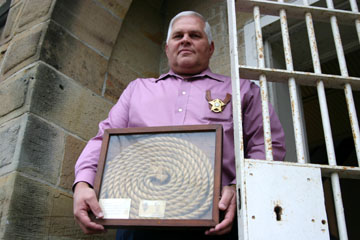 Moments later, the prisoner, suddenly agile and fast-thinking, slipped from his cell, hurried downstairs, and retrieved a .38 Colt pistol from one of the jailers’ desks. Deputy Sheriff Tom Jones confronted the convicted killer, and Ratliff shot him five times before jailer “Pack” Kilborn, a former sheriff, wrestled the gun away and returned Ratliff to his cell. Jones, suffering from wounds in the abdomen, chest, and shoulder, was rushed to the hospital. Outside the jail, Eastland residents held quiet vigil for the badly injured deputy. Throughout the next day, the crowd grew steadily. By 8 p.m., an estimated 2,000 people had gathered, and anger was spreading through the crowd.
Moments later, the prisoner, suddenly agile and fast-thinking, slipped from his cell, hurried downstairs, and retrieved a .38 Colt pistol from one of the jailers’ desks. Deputy Sheriff Tom Jones confronted the convicted killer, and Ratliff shot him five times before jailer “Pack” Kilborn, a former sheriff, wrestled the gun away and returned Ratliff to his cell. Jones, suffering from wounds in the abdomen, chest, and shoulder, was rushed to the hospital. Outside the jail, Eastland residents held quiet vigil for the badly injured deputy. Throughout the next day, the crowd grew steadily. By 8 p.m., an estimated 2,000 people had gathered, and anger was spreading through the crowd.
Finally, two dozen men stormed the jail and knocked jailer Kilborn to the floor, pinning him there as they took his keys. The mob then raced upstairs to the cell where a nude Ratliff lay on his bunk. Taking the prisoner outside, stepping to the angry chant of the crowd, they moved the inmate near a telephone pole and placed a noose around his neck. They threw the rope over the guy wires and lifted Ratliff from the ground. The rope broke. Another was quickly found, and he was jerked 15 feet off the ground. His body dangled there for 20 minutes before a county judge and justice of the peace arrived and ordered it taken down.
According to a granite monument that now stands on the corner of White and Mulberry streets in Eastland, it was the last mob lynching ever carried out in Texas. No legal action was ever brought against any of the participants. By the time Marshall Ratliff died at the end of that rope, the casualty toll of the ill-planned bank robbery was staggering, especially for small-town Texas in that era. Davis and Helms were dead, Helms having been executed in Huntsville two months before the lynching. Two Cisco police officers, Bedford and Carmichael, had been murdered in the gunplay immediately following the robbery. And Eastland jailer Tom Jones died from his gunshot wounds the day after Ratliff was hanged.
Six citizens had been wounded. The Palo Pinto County sheriff, who had joined the manhunt, lost two fingers and was wounded in the leg when his pistol discharged by accident as he was chasing the fugitives. Robert Hill escaped from prison twice but was caught and returned to Huntsville both times. He was granted parole in the 1940s and is said to have changed his name and moved back to West Texas – perhaps Midland or Odessa – where it is believed he lived out the remainder of his life as a law-abiding citizen.
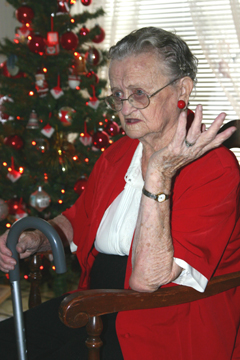 Olga Fay Parker, now 93, lived not far from the bank. She was 13 and playing in the yard, she said, when she heard the shots. Parker became frantic with worry because her older sister, Nona, was working at a jewelry store just north of the bank. An elderly neighbor came out and consoled her. Parker attended school with one of the hostages, Robinson, and recalled how the incident traumatized the girl. On the orders of teachers, students didn’t pester her about the ordeal. “She didn’t say much; it was hard for her,” Parker told Fort Worth Weekly. Nona, on the other hand, had been terrified during the shootout, her sister said, but she handled the shock differently – she talked about the incident almost every day for many years.
Olga Fay Parker, now 93, lived not far from the bank. She was 13 and playing in the yard, she said, when she heard the shots. Parker became frantic with worry because her older sister, Nona, was working at a jewelry store just north of the bank. An elderly neighbor came out and consoled her. Parker attended school with one of the hostages, Robinson, and recalled how the incident traumatized the girl. On the orders of teachers, students didn’t pester her about the ordeal. “She didn’t say much; it was hard for her,” Parker told Fort Worth Weekly. Nona, on the other hand, had been terrified during the shootout, her sister said, but she handled the shock differently – she talked about the incident almost every day for many years.
Smith, the playwright, spent a lot of time in recent years looking fruitlessly for even one remaining eyewitness of that bloody and historic day. Thus, like all contemporary tellers of the story, he relied on the collective efforts of historians when he wrote his locally popular musical, which debuted at Cisco’s Big Country Dinner theater in 2006 and was performed again last summer. “We had a big turnout for that,” said retired county judge Scott Bailey.
Staff writer Jeff Prince contributed to this story; a version of it first appeared in the Abilene Reporter-News.
Author Carlton Stowers was the recent recipient of the A.C. Greene Literary Award at the West Texas Book & Music Festival. He has also twice won the Mystery Writers of America’s Edgar Allan Poe Award for the Best Fact Crime Book of the Year.











